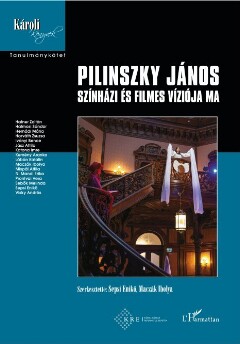

OCR
ABSTRACTS ENIKŐ SEPSI The legacy of Pilinszky's theatrical and cinematic vision in poetry, paper theatre, and on stage The following study examines the poetic implications of Pilinszky’s theatrical approach to the rite and ceremony, as well as his views on the witness state, at a time when the liturgy and ceremony also appeared in Robert Wilson’s thinking about theatre. The research published in my book on the immobile theatre of Janos Pilinszky in French and then in Hungarian is based primarily on two letters I discovered in the early Robert Wilson Archives at Columbia University. I take this research in a chapter of my book Poetic Images, Presence, and the Theater of Kenotic Rituals published this year at Routledge Publishing House in the direction of poetic ritualism, which I briefly describe here in Hungarian. In the second half of this essay, I will discuss the study of the mechanism of action of poetic rituals in the case of some contemporary artists (performances and poems). ANDRAS VISKY “The only book of aesthetics”. Conversations with Sheryl Sutton as a drama Janos Pilinszky’s last book Conversations with Sheryl Sutton: The Novel of a Dialogue is a unique attempt in the history of theatre at a systematic aesthetics of theatre. More than this, the book, written in the form of the Augustinian dialogues, proves to be asummary of Pilinszky’s oeuvre, which suggests that besides the theatre experiments, his highly acclaimed poetry is also a performative endeavor, designed to trigger a radical self-reflection and catharsis for his readers. In Pilinszky’s view the Christian culture has fallen in the Second World War, and its cleansing is possible only by means of the theatre and arts in general. Our paper, written in dialogues as homage to the author of Conversations with Sheryl Sutton: The Novel of a Dialogue, aims to demonstrate that Pilinszky’s book as an aesthetic legacy is written deliberately in the shape of a play, and its meanings remains in the shadow unless we read it as post-dramatic, initiative writing. To prove this thesis we read Pilinszky’s masterpiece from multiple points of views, including Origen’s The Song of Songs. Commentary and Homilies, Roman Ingarden’s The Literary Work of Art, Peter Szondi’s Theory of the Modern Drama, and Hans-Thies Lehmann’s Postdramatic Theatre. e 239 "
Strukturell
Custom
Image Metadata
- Bild Breite
- 1867 px
- Bild Höhe
- 2671 px
- Bild Auflösung
- 300 px/inch
- Dateigröße
- 1 MB
- Permalink zum JPG
- 022_000072/0240.jpg
- Permalink zur OCR
- 022_000072/0240.ocr
Benutzeranmeldung
Deutschde
